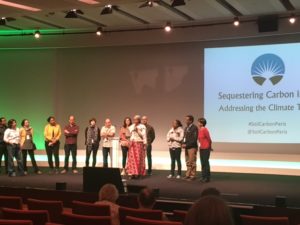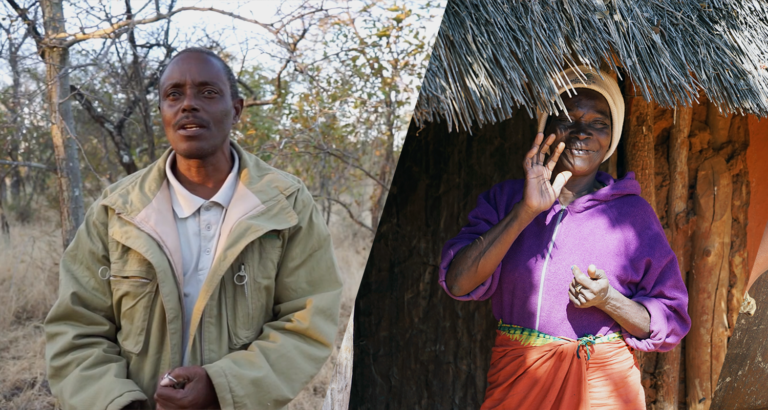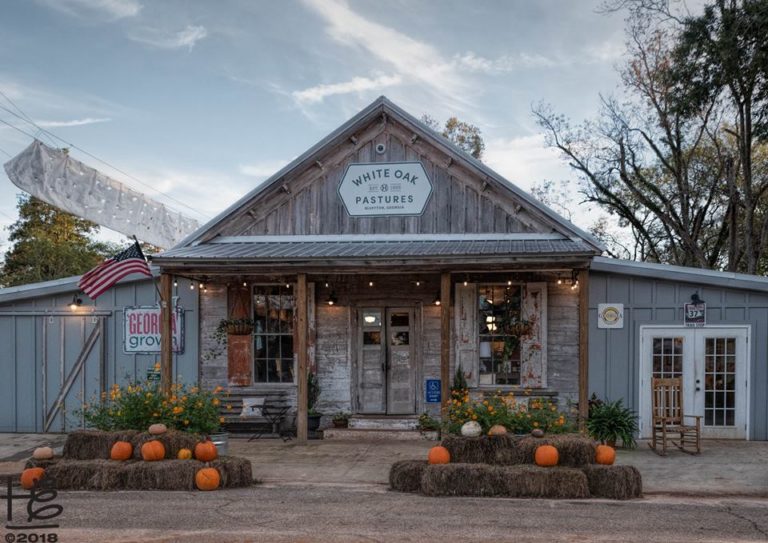A report on Sequestering Carbon in Soil: Addressing the Carbon Threat gathering – Paris, France.
Agricultural soils, including grasslands, have been clearly recognized as huge potential sinks for carbon if properly managed.
The loss of more than half of carbon stocks in the world’s agricultural soils from poor practices can be restored by practices that regenerate biological diversity and soils. Current agriculture has resulted in massive losses of biological diversity, leading to bare ground, desertification, and the erosion of almost 80 billion tons of soil/year – that is 10 tons of soil lost per 1 ton of food needed per capita/year. This has impact in cities and off site, on waterways and marine life. Reversing these trends, and fast, will require the agriculture sector to take a courageous stand and challenge its current industrial models, which favor efficiencies of scale to the detriment of long term ecological, social and financial resilience. Agriculture can coexist with thriving landscapes and communities if designed to foster soil health and biological diversity and complexity. Soil health not only contributes to carbon sequestration, a great benefit in terms of climate mitigation, but has the added benefits of increased fertility, inherent land productivity, and water retention, bolstering food production and security.
French Minister of Agriculture’s 4 per 1,000 initiative presented at the COP 21 conference on carbon sequestration late last year has activated a promising dialogue and commitments by nations to achieve annual soil carbon increases on agricultural lands of 0.4 percent—the equivalent of nearly one-third of current carbon emissions.
On May 3-5, Savory Institute’s CEO, Daniela Ibarra-Howell, and leaders of the Savory global network, joined 200 soil carbon scientists, policy experts, ranchers, land managers, nongovernmental groups, investors, philanthropists, and government officials from around the world in an unprecedented gathering of soil leaders: Sequestering Carbon in Soil: Addressing the Carbon Threat, in Paris. The objective was to explore, dream, and showcase innovative and relevant research, pilot projects, policies, financial structures, and incentives for hastening adoption of carbon sequestration strategies and tactics with the potential to help ensure a global carbon budget that keeps global temperature rise to no more than 1.5°C.

Pictured above: UK farmer, Patrick Holden of Sustainable Food Trust, Australian scientist, Christine Jones of Amazing Carbon, Daniela Ibarra-Howell of the Savory Institute, US farmer Julie Rawson of the Northeast Organic Farming Association, and Ronnie Cummins, US Organic Consumer Association (OCA).
The conference explored the state of our scientific understanding, results from field trials, emerging policy frameworks, and proposals to accelerate progress and build the field of soil health and carbon sequestration globally. Speakers and participants highlighted agricultural approaches that build carbon stocks in the soil, including agroforestry, holistic grazing practices including silvopasture and pasture cropping, and cover crops among others.
Research presented at the conference seemed to point both to the potential and the limitations of regenerative practices in addressing the climate threat. However, according to Australian soil microbiologist Christine Jones, some of the proposed rates, mainly in grasslands landscapes, lagged because researchers are primarily evaluating current practices or practices that are perceived to be sustainable. “They are not looking at the innovators who are getting higher rates,” she said, adding that estimates tend to consider “the top increments of the soil profile,” whereas the largest, most stable carbon increases occur at root level, which in perennial or intercropped pasture systems can be several meters deep. Soil carbon saturation—the theoretical limit for soil carbon uptake—would not be a factor for thousands of years “and certainly not a reason to not do it,” said Jones. This much larger potential we have known and witnessed for many years among our global producer network of holistic managers. Holistic planned grazing results in measurable and significant increase in biological diversity above ground. The increases in numbers and diversity of perennial plant species trigger a host of soil dynamics and microbiology below the ground that activate the humification process by which carbon is safely bound in complex and long lived molecules that render soils healthy and productive. Researchers were invited to get closer to regenerative producers and base their research on the observation of outcomes on these lands. Savory Global network provides a fantastic opportunity to study the outcomes of regenerative pastoralists in different ecological and cultural contexts, using different implementation tactics as they holistically plan their grazing. The work of our colleagues Jason Rowntree (Michigan State University) and Richard Teague (Texas A&M) present at the conference, is aligned with this desired research design, and we look forward to continue learning with them and other research partners, such as our neighbors at Colorado State University, also in attendance.

Photo: Participants called for a holistic, rather than reductionist, view of soil carbon – addressing the issue wholeheartedly from the perspective of ecosystem health, biological diversity, water and food security, and social equity and wellbeing.
Another point strongly highlighted at the conference was the importance of integrating scientific and local knowledge, including regenerative indigenous practices that small holders in Latin America and Asia, for example, have been practicing for thousands of years. A group of participants representing these cultures issued a statement expressing concern that a narrow focus and “western worldview” on soil carbon and carbon markets could lead to a “commodification” of soil with the unintended consequence of increased corporate control of agricultural lands. It was suggested that a greater emphasis on improving the livelihoods and sovereignty of small holders will lead to healthy soils rich in organic matter, and resilient food production, ultimately contributing to the mitigation of climate change.
With renewed hope and commitment the call is now for operationalizing these commitments and knowledge. Christiana Figueres, former executive secretary of the U.N. Framework Convention on Climate Change properly urged all participants in the room to not fall in the “science or knowledge perfection paralysis” trap. It was clear our knowledge of how to rebuild soil carbon is adequate and enough. We will continue to learn, but we must act and scale what we know is already working for soils, people, and planet. Amen!





